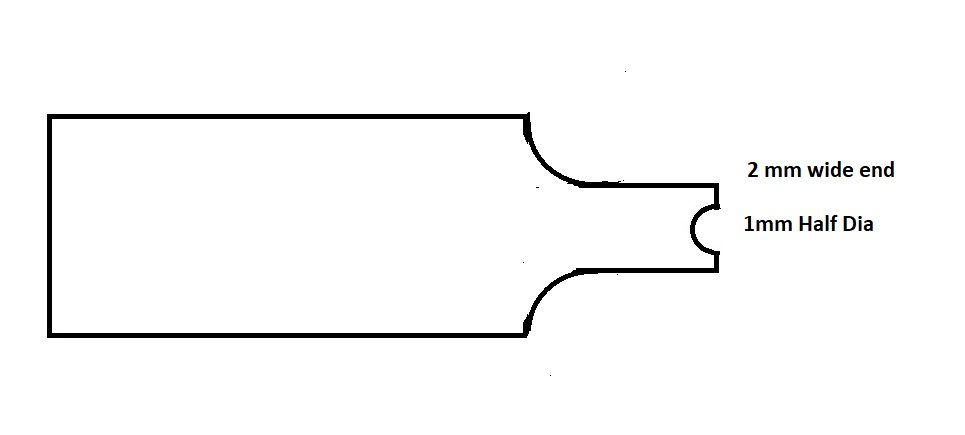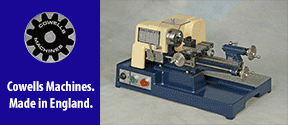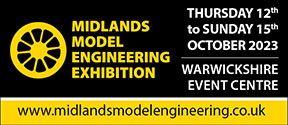Is this doable?
| Chris TickTock | 17/09/2020 11:21:11 |
| 622 forum posts 46 photos | Hi Guys, I am thinking of making a cutter for experimental reasons. The issue is the cutter has to be made from silver steel which after machining is hardened and tempered. But the tip of the cutter is reduced to 2mm wide and a 1mm half diameter milled into it. The 1mm is the issue I think but as I don't have a 1mm yet don't know so am asking. The depth of metal at the tip will be roughly 3mm. The cutter is designed to round edges on steel...whether it will work or not don't worry about that as it is as I said an experiment. But can I mill the 1mm half Dia, if not is there an alternative way. Regards |
| roy entwistle | 17/09/2020 11:26:55 |
| 1716 forum posts | Try it and see |
| John Olsen | 17/09/2020 11:28:08 |
| 1294 forum posts 108 photos 1 articles | File it with a round swiss needle file. |
| Peter Hall | 17/09/2020 11:32:28 |
| 115 forum posts 1 photos | Drill a 1mm hole and file it back. Pete |
| Perko7 | 17/09/2020 11:33:39 |
| 452 forum posts 35 photos | Shape the end but leave it a bit longer, then drill a 1mm hole near the end and grind or mill away the bit you don't want. |
| SillyOldDuffer | 17/09/2020 14:53:33 |
| 10668 forum posts 2415 photos | No problem buying 1mm end-mills if you want to have a go but they're easily broken. Tricky to use because home machines are rarely fast enough : a 1mm end-mill should be run at 10,000 rpm or faster. 50000rpm would be good! When feed rate exceeds cutting speed, the work snaps the cutter. And it's difficult to keep the feed-rate low enough to suit a 1mm end-mill spinning at only 3000 rpm. Low rpm on small cutters and drills make them sensitive to any hint of operator clumsiness. At 10000+ rpm, the end-mill cuts fast enough for the feed-rate to become manageable, otherwise develop a delicate touch! Worth looking at the spindle motors used for engraving machines and CNC if a lot of small diameter work is planned 12000rpm seems typical, faster the better. I'd make the occasional tool described it by drilling a 1mm hole and grinding off as the other posts say. When the cutter is made, note that it too will work best at high rpm. If finish is poor, try speeding up and/or reducing feed-rate. Don't have much experience of delicate cutting work like this. Much breaking, bending and poor finish when I try. More practice might fix my problems. Can you report back how your experiment works out? I might learn summat! Dave |
| DiogenesII | 17/09/2020 15:32:07 |
| 859 forum posts 268 photos | ..and maybe try and give it some front clearance (angle).. it need only be small.. |
| Gary Wooding | 17/09/2020 15:42:12 |
| 1074 forum posts 290 photos | I'm with the 1mm drill set, but in order to provide bottom rake I'd drill at an angle of approx 6°, then file the end off to create the semi-circle. |
| Chris TickTock | 19/09/2020 18:23:48 |
| 622 forum posts 46 photos | Posted by SillyOldDuffer on 17/09/2020 14:53:33:
No problem buying 1mm end-mills if you want to have a go but they're easily broken. Tricky to use because home machines are rarely fast enough : a 1mm end-mill should be run at 10,000 rpm or faster. 50000rpm would be good! When feed rate exceeds cutting speed, the work snaps the cutter. And it's difficult to keep the feed-rate low enough to suit a 1mm end-mill spinning at only 3000 rpm. Low rpm on small cutters and drills make them sensitive to any hint of operator clumsiness. At 10000+ rpm, the end-mill cuts fast enough for the feed-rate to become manageable, otherwise develop a delicate touch! Worth looking at the spindle motors used for engraving machines and CNC if a lot of small diameter work is planned 12000rpm seems typical, faster the better. I'd make the occasional tool described it by drilling a 1mm hole and grinding off as the other posts say. When the cutter is made, note that it too will work best at high rpm. If finish is poor, try speeding up and/or reducing feed-rate. Don't have much experience of delicate cutting work like this. Much breaking, bending and poor finish when I try. More practice might fix my problems. Can you report back how your experiment works out? I might learn summat! Dave Useful to me Dave as yet I was not aware different speed requirements per size end mill. Something else for me to learn. Chris |
Please login to post a reply.
Want the latest issue of Model Engineer or Model Engineers' Workshop? Use our magazine locator links to find your nearest stockist!
Sign up to our newsletter and get a free digital issue.
You can unsubscribe at anytime. View our privacy policy at www.mortons.co.uk/privacy
- hemingway ball turner
04/07/2025 14:40:26 - *Oct 2023: FORUM MIGRATION TIMELINE*
05/10/2023 07:57:11 - Making ER11 collet chuck
05/10/2023 07:56:24 - What did you do today? 2023
05/10/2023 07:25:01 - Orrery
05/10/2023 06:00:41 - Wera hand-tools
05/10/2023 05:47:07 - New member
05/10/2023 04:40:11 - Problems with external pot on at1 vfd
05/10/2023 00:06:32 - Drain plug
04/10/2023 23:36:17 - digi phase converter for 10 machines.....
04/10/2023 23:13:48 - More Latest Posts...
- View All Topics
- Reeves** - Rebuilt Royal Scot by Martin Evans
by John Broughton
£300.00 - BRITANNIA 5" GAUGE James Perrier
by Jon Seabright 1
£2,500.00 - Drill Grinder - for restoration
by Nigel Graham 2
£0.00 - WARCO WM18 MILLING MACHINE
by Alex Chudley
£1,200.00 - MYFORD SUPER 7 LATHE
by Alex Chudley
£2,000.00 - More "For Sale" Ads...
- D1-3 backplate
by Michael Horley
Price Not Specified - fixed steady for a Colchester bantam mark1 800
by George Jervis
Price Not Specified - lbsc pansy
by JACK SIDEBOTHAM
Price Not Specified - Pratt Burnerd multifit chuck key.
by Tim Riome
Price Not Specified - BANDSAW BLADE WELDER
by HUGH
Price Not Specified - More "Wanted" Ads...
Do you want to contact the Model Engineer and Model Engineers' Workshop team?
You can contact us by phone, mail or email about the magazines including becoming a contributor, submitting reader's letters or making queries about articles. You can also get in touch about this website, advertising or other general issues.
Click THIS LINK for full contact details.
For subscription issues please see THIS LINK.
Model Engineer Magazine
- Percival Marshall
- M.E. History
- LittleLEC
- M.E. Clock
ME Workshop
- An Adcock
- & Shipley
- Horizontal
- Mill
Subscribe Now
- Great savings
- Delivered to your door
Pre-order your copy!
- Delivered to your doorstep!
- Free UK delivery!











 Register
Register Log-in
Log-in


